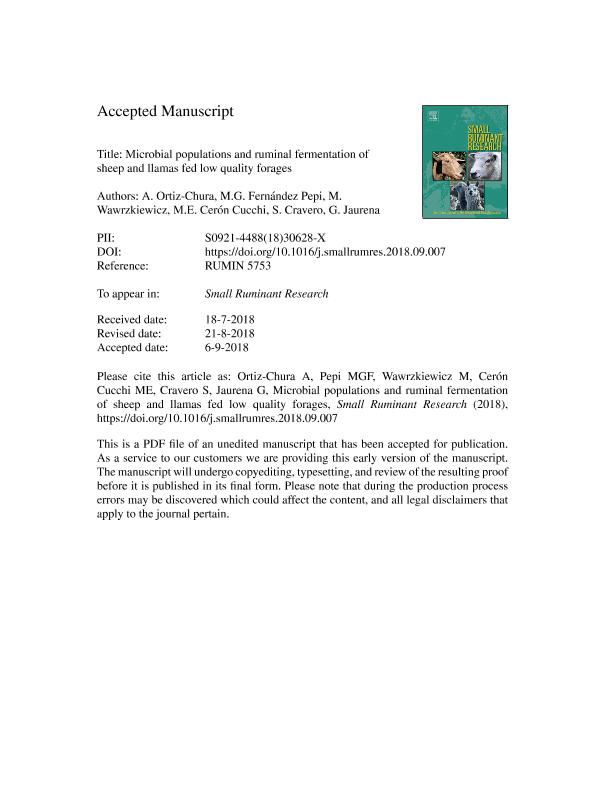Artículo
Microbial populations and ruminal fermentation of sheep and llamas fed low quality forages
Ortiz Chura, Abimael ; Fernández Pepi, María Gabriela
; Fernández Pepi, María Gabriela ; Wawrzkiewicz, Marisa; Cerón Cucchi, María Esperanza
; Wawrzkiewicz, Marisa; Cerón Cucchi, María Esperanza ; Cravero, S.; Jaurena, G.
; Cravero, S.; Jaurena, G.
 ; Fernández Pepi, María Gabriela
; Fernández Pepi, María Gabriela ; Wawrzkiewicz, Marisa; Cerón Cucchi, María Esperanza
; Wawrzkiewicz, Marisa; Cerón Cucchi, María Esperanza ; Cravero, S.; Jaurena, G.
; Cravero, S.; Jaurena, G.
Fecha de publicación:
11/2018
Editorial:
Elsevier Science
Revista:
Journal of Small Ruminant Research
ISSN:
0921-4488
Idioma:
Inglés
Tipo de recurso:
Artículo publicado
Clasificación temática:
Resumen
The objective of this study was to assess the ruminal microbial population and fermentation of sheep and llamas fed low quality forages. Two llamas and three sheep with permanent ruminal cannula were fed ad libitum with a low quality fescue hay (Festuca arundinacea Schreb). The animals were adapted to forage feeding for 21 days, followed by one day of collection of the ruminal fluid (RF), during 2 experimental periods separated by 7 days. The RF was extracted before morning feeding. The llama forestomach content showed higher degree of fermentative activity than the sheep one, as indicated by NH3-N and VFA values (P < 0.001). Similar densities of total bacteria, methanogens and fibrolytic bacteria were present in both species (P > 0.050). However, the forestomach of llamas contained higher density of total protozoa and Eudiplodinium (P < 0.050), whereas holotrich protozoa were undetectable. In conclusion, the llama forestomach had higher fermentative activity than sheep rumen, different protozoa population, but no differences in bacterial population densities.
Palabras clave:
BACTERIA
,
CAMELIDS
,
FORESTOMACH
,
METHANOGENS
,
MICROBIOTA
,
PROTOZOA
Archivos asociados
Licencia
Identificadores
Colecciones
Articulos (IPVET)
Articulos de INSTITUTO DE PATOBIOLOGIA VETERINARIA
Articulos de INSTITUTO DE PATOBIOLOGIA VETERINARIA
Citación
Ortiz Chura, Abimael; Fernández Pepi, María Gabriela; Wawrzkiewicz, Marisa; Cerón Cucchi, María Esperanza; Cravero, S.; et al.; Microbial populations and ruminal fermentation of sheep and llamas fed low quality forages; Elsevier Science; Journal of Small Ruminant Research; 168; 11-2018; 47-51
Compartir
Altmétricas



